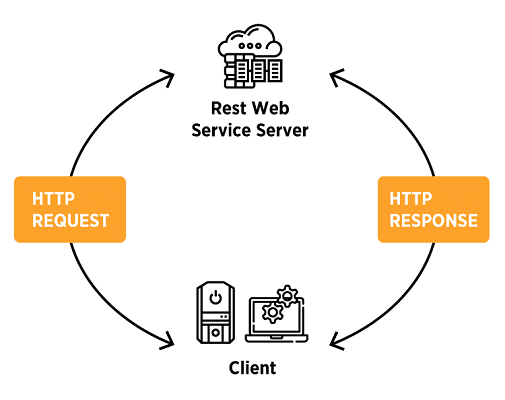navigation

Originally published February 20, 2020, updated April 14, 2021
We as consumers prioritize convenience above all else. We want to purchase anywhere, anytime, with little thought given to what happens behind the scenes. While this idea has permeated traditional B2C shopping channels, B2B eCommerce businesses are also responding to changing market demands and customer expectations.
This is where the eCommerce API comes in: it offers a level of convenience, scalability, agility, and reduced costs that B2B eCommerce businesses need to stay competitive.

With the power of API, sellers can build and deliver the solutions their business clients demand. Solutions that address unique, complex business models that differ from one customer to the next. Thus, eCommerce APIs can improve individual customer experiences, including seamless product selection, ordering, payments, shipping, and more.
What Is an eCommerce API?
As the name suggests, the API (application programming interface) is an interface between two systems that allow them to communicate. Any communication must first be initiated, so one party sends a request to the other party, which sends a response after running a program. Programs facilitate these messages, which are governed by several rules that lead to a predetermined function.

In the context of an eCommerce site, an API is the communication process that allows the eCommerce platform to talk to other applications, such as the ERP (enterprise resource planning) system, and retrieve specific product, order, or fulfillment data. Since the distribution ERP software only allows access to specific data points, you’re limited by what kind and how much data you can transfer.
How Do Sellers Benefit From an eCommerce API?
There are many benefits of using eCommerce APIs. Smooth data exchange improves numerous facets of your business, ranging from better internal productivity, user experience, and ultimately sales. Let’s take a look at them in more detail.
Improved customer experience
The B2B buyer is just like any buyer, inherently aware of the power and influence they wield with their wallets. Research has shown that the customer experience correlates to loyalty and retention, as well as the customer’s willingness to repurchase, to switch brands, or to recommend the brand to others.
APIs help B2B eCommerce merchants personalize through individualized back-office insights. They can help you construct an accurate model using customer behavior and activities such as when, where and what they do on your eCommerce store.
Improved conversion and sales
The increasingly mobile and connected world makes the customer experience only half of the battle. B2B sellers must be able to keep track of business customers as they navigate to their purchase through various channels. In this sense, an API can be used to increase consistency across channels that may have been neglected.
APIs can help the B2B customer take advantage of coupons, company-specific discounts, or deliver custom, account-specific checkout experiences, boosting a conversion rate no matter where the customer begins their purchasing journey.
Improved connectivity
One of the main objectives of B2B eCommerce businesses is to make it easier for their customers to run their businesses. The API acts as building blocks for the realization of numerous parallel shopping and buying experiences. Additionally, an eCommerce API integration offers B2B sellers the flexibility to connect directly with platforms they use in their back-office operations.
APIs unleash more flexibility out of your eCommerce platform, allowing your business clients to integrate it with their systems. They, in turn, can use the API to pass on information to their own systems, or platforms intended for use by their partners or customers.
What Are the Types of B2B eCommerce APIs?
There are three main types of APIs used by B2B eCommerce businesses to help them reach various objectives. Let’s consider these approaches in more detail and look at some examples of each.

[Source]
- Public or open APIs are publicly available APIs for third-party developers. These have minimal restrictions – they lack licensing fees and often ample documentation. Their primary aim is to improve the developer’s experience, facilitate brand awareness and facilitate the spread of their API to create and test applications.
These APIs can retrieve publicly available data from other eCommerce stores into your own and fetch and update product content such as multimedia, descriptions, and prices.
- Partner APIs are limited to strategic business partners and are usually shared with those who have a contractual agreement with the publisher. They are not available publicly, but developers can use a developer portal to facilitate development.
A common use case for partner APIs is for eCommerce integration. Companies that grant partners access to APIs can benefit from additional data collection, brand awareness, and extra revenue streams. - Internal or private APIs are hidden from external users and partners and are only exposed internally. These are used by in-house developers to integrate internal systems together or to work with external partners. This gives businesses more control of the API and allows them to maximize its effectiveness.
An example of an internal API is a connection between two products that depend on back-end functionality to integrate them. Internal APIs can draw on shared resources or facilitate collaboration between departments, channels, and applications. It also allows for faster development and deployment.
Data Protocols, Message Formats, and Approaches
Like any web based API, an eCommerce API consists of a protocol, a set of rules that define how applications interact, and the format, which is how data is sent and retrieved by the other application. These consist of internet protocols such as HTTP, SMTP and message formats such as JSON and XML used primarily by REST and SOAP APIs.
JSON and XML message formats
Web APIs usually make HTTP requests (a protocol used by web browsers) and process JSON or XML responses. JSON is a more lightweight and readable format, which saves time and speeds up web interchanges. On the other hand, XML offers more flexibility for complex expressions.
The REST vs. SOAP approach
Both REST (short for Representational State Transfer) and SOAP (Simple Object Access Protocol) utilize HTTP or SMTP for sending requests and receiving responses. However, there are some differences to keep in mind.
- SOAP is a protocol that relies on HTTP or SMTP for sending requests and receiving responses. It comes with strict rules that guarantee reliability and security but offers higher complexity, which translates to more bandwidth and resource use.
- REST is not a protocol but an architectural principle with specific characteristics. These include giving the client the ability to request or modify a resource and receive a response from the server. REST is easier to implement, and unlike SOAP, which only permits XML, it supports many data formats. For example, JSON support making REST popular for browser clients.
Digital commerce REST APIs can transfer virtually any type of data from customer, order, fulfillment and shipping data. Since SOAP APIs are tightly coupled to the server, they are often used in managing secure information such as eCommerce payments and payment-related information.
Comparing REST and SOAP API Methods
| SOAP | REST | |
| Stands for | Simple Object Access Protocol | Representational State Transfer |
| Transfer protocol | HTTP, SMTP, and more. | HTTP |
| Message format | Exposes application logic as service via XML | Components interact via a uniform interface through Text, HTML, XML, JSON, YAML, and more |
| Approach | Function-driven with data as part of a service or command | Data-driven with data serving as resources |
| Rules | Strict rules and advanced security requirements | Loose guidelines and recommendations |
| Implementation and performance | More bandwidth and computing power required | Fewer resources needed |
| Statefulness | Both stateless and stateful depending on design | Stateless, no data is stored on application server |
| Security | WS-Security, SSL support, and ACID compliance | HTTPS and SSL |
| Caching | No | Yes |
As the above demonstrates, both SOAP and REST share some similarities, such as HTTP protocols, XML usage, and SSL support. At the same time, SOAP offers much more rigidity and standardization at the expense of higher processing requirements. Both of these systems greatly depend on their environment and its specifications. Their design must consider everyone that will ultimately interact with these systems.
What Are Some Business Uses of eCommerce API?
Now that you understand how eCommerce APIs work and some of their roles within your eCommerce website, let’s explore how they can be utilized in your business.
1. Business Integration
Business sellers seek eCommerce solutions for double duty: to get their eCommerce managers, sales and support staff working more effectively and to help their business customers reach their goals. This means going beyond the self-service portal and accommodating their smallest shopping, ordering, and purchasing preferences.
B2B buyers can use eCommerce API integration and push data directly to their ERP, CRM, PIM (product information management) and other business systems, reducing manual data entry and human error. Open storefront eCommerce APIs make it possible to feed necessary product data to your business clients’ preferred systems without the need to invest in complex integrations with multiple 3d-party systems. Lastly, the API can be used to rebrand or recreate self-service portals from scratch to better meet the needs of end-users making lesser-known business models like B2B2B and B2B2C easy to manage.
2. Headless eCommerce
Businesses with traditional eCommerce platforms must concede with adapting their solution to their tech stack – rather than having their tech stack adapt to their business needs. Headless architecture does away with these limitations with the flexibility and agility to build personalized experiences.
The headless eCommerce API approach allows brands to operate multiple CMSs (content management systems) or administer multichannel eCommerce and multi-website experiences. Robust APIs allow for added personalization capabilities, offering B2B buyers a custom-tailored storefront, web, phone, smartwatch, television or voice-activated purchasing. All this can be unified behind a single back-office platform – a single location from which sellers can administer unified branded experiences. In a headless scenario, APIs are used between multiple systems to communicate with each other, effectively decoupling the back-end from what happens on the front-end.
3. PWA (Progressive Web App)
A PWA is a web application that runs as a website while offering an app-like experience to users. It has promising uses in B2B eCommerce, offering mobile business users a quick-loading and lightweight mobile experience without the high development costs of native apps. Best of all, PWAs make laser-focused personalization that enhances the user experience possible, increasing engagement and conversion rates for your target audience.
Developing a PWA makes extensive use of your eCommerce API. As such, it’s critical to have a robust, scalable and expandable API capable of flexible data transfer. For example, with OroCommerce’s REST API, developers can implement service workers, web storage, ordering, payment, push notifications, and more – helping you bring the most complex PWAs to life.
OroCommerce’s eCommerce APIs Helps Businesses
OroCommerce is a B2B eCommerce platform based on enterprise-grade open-source architecture. It’s ideal for mid-market and enterprise B2B brands in any industry vertical looking to establish or grow their digital presence. It also comes with features like multi-website management capabilities, robust workflows, and extensive customization options out of the box.
Mid to large-scale brands utilize OroCommerce’s open source API to improve back-office productivity, and improve relationships with their customers, and realize powerful user experiences. Here are some of the ways Oro’s commerce APIs help brands achieve success in their respective industries:
Animal Supply Company

Aside from selling pet supplies to its retail partners, Animal Supply also provides 3rd party logistics services to its network of retailers across every corner of the United States.
Animal Supply utilizes hosted shopping carts and platforms like Amazon, so they had complex requirements for their warehousing, inventory, shipping and commerce needs.
As Animal Supply grew through mergers and acquisitions, they inherited various order processing systems that OroCommerce was able to centralize. Acting as an order management system on behalf of multiple ordering channels, OroCommerce gathers information from Animal Supply’s ERPs and warehousing systems to process orders for a number of business users and end-users.
All this was made possible by OroCommerce’s open source headless architecture that connects via eCommerce API integration to Animal Supply’s mobile application. To learn more about how Animal Supply Company was able to roll out a customer-first storefront in record time, read their success story here.
Petra Industries

As Petra Industries outgrew their B2C-oriented solution, they started looking for a B2B-specific platform that could help in everything from onboarding customers more effectively, to carrying out orders, to executing better marketing campaigns.
Petra completely decoupled their eCommerce back-end and was able to build an effortless mobile journey for their customers’ clients as a result. Petra now offers a consistent site-wide experience with time-saving quick order forms and CSV file uploads. They implemented a native OroCommerce integration and pulled in data from their Akeneo PIM and MDS ERP. Learn more about Petra Industries and their successful transformation here.
Making the Case For B2B eCommerce API
For B2B sellers, making shopping easy is not as straightforward as it is for B2C businesses. That’s because B2B buyers are an uncompromising bunch: they want the same effortless, omnichannel shopping experience they’ve come to expect as B2C customers, but with all the convenience around custom price lists, individual product catalogs, quote management, ordering workflows, and more.
A proper eCommerce API allows B2B sellers to give their buyers every reason to stick with them. Vendors can integrate their back end into ERPs, CRMs, and eCommerce PIM systems, or merge payment functionality with a payment gateway, for example. By decoupling the back-end form the front-end and have them communicate via API, B2B businesses can utilize the full benefit of headless eCommerce for their needs.
Fortunately, open-source platforms such as OroCommerce are able to leverage headless with support for various PWA frameworks such as Front-Commerce, helping you realize projects of any size and complexity.
Questions and Answers
What is an eCommerce API?
The eCommerce API is an interface between two systems that allows them to communicate with one another. A powerful API not only enables integrations with solutions B2B businesses rely on but can be customized to work with many different data points and third-party software.
What are the different types of eCommerce APIs?
There are three main types of API models. Public APIs, which are open to the public and designed to help third-party developers integrate with the eCommrce system; partner APIs, which are limited to business partners; and internal APIs, which are private and only exposed to internal developers or partners.
What is a B2B eCommerce API integration?
Unlike a B2C eCommerce platform, a B2B platform must effectively get B2B data to the right place. Since B2Bs deal with greater volumes and varieties of data than B2C businesses, they require flexible, robust APIs to accommodate complex integrations and enable the use of AI in eCommerce.





